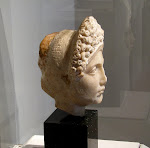 The scientific excavation and study of ancients sites around the Mediterranean has been going on for almost 150 years. It's hard not to trip over ancient cities and towns of the Greeks and Romans, not to mention the many other diverse cultures that have thrived throughout history. For centuries the various modern cultures of Europe have been fascinated by the ancient world. This interest was easily fueled by the convenient ruins strung about Europe, especially in cities like Rome and Athens. As far back as the middle ages, we have accounts of ruins and objets d'art being dug up and appreciated. It has not been until relatively recent times, though, that attention was turned away from land and towards the sea. It has never been a secret that the Mediterranean Sea contains countless ship wrecks containing who knows what. Tantalizing clues have occasionally been pulled from the sea floor; the Antikythera Mechanism and the Riace Bronzes come to mind. Scuba diving only became practicable and popular after WWII, so much less time has been spent in dealing with underwater archaeology that traditional land based archaeology. Even today, underwater archaeology is a small specialized field, due mostly to the costs involved.
The scientific excavation and study of ancients sites around the Mediterranean has been going on for almost 150 years. It's hard not to trip over ancient cities and towns of the Greeks and Romans, not to mention the many other diverse cultures that have thrived throughout history. For centuries the various modern cultures of Europe have been fascinated by the ancient world. This interest was easily fueled by the convenient ruins strung about Europe, especially in cities like Rome and Athens. As far back as the middle ages, we have accounts of ruins and objets d'art being dug up and appreciated. It has not been until relatively recent times, though, that attention was turned away from land and towards the sea. It has never been a secret that the Mediterranean Sea contains countless ship wrecks containing who knows what. Tantalizing clues have occasionally been pulled from the sea floor; the Antikythera Mechanism and the Riace Bronzes come to mind. Scuba diving only became practicable and popular after WWII, so much less time has been spent in dealing with underwater archaeology that traditional land based archaeology. Even today, underwater archaeology is a small specialized field, due mostly to the costs involved.
Saturday, July 25, 2009
Two Exciting New Underwater Discoveries
Posted by
Primvs Pilvs
at
8:28 AM
0
comments
![]()
Monday, July 6, 2009
Generous Gift Showcases Roman Mosaic
 The Romans used mosaic art extensively throughout their empire. From Britain to the Middle East, examples of many different mosaic techniques have been discovered. Like much of Roman art, the mosaic technique was something that they absorbed and modified to suite their own artistic needs. The earliest mosaic examples come from Mesopotamia, dating from the 2nd millennia BCE. Those examples are primarily geometric in design using different colored tesserae. The Ancient Greeks embraced mosaics, decorating their floors with geometric designs made of tesserae or pebbles. In the royal Macedonian city of Pella we find some wonderful examples of figurative scenes executed in mosaic and during the Hellenistic period mosaic art would reach a new height. It is from the Hellenistic model that the Romans developed their mosaic art. Many famous Roman mosaics, such as the Alexander Mosaic from Pompeii, are thought to be based on Hellenistic paintings. Pompeii is famous for its many beautiful mosaics, but elsewhere in Italy and throughout the Roman world, many astounding mosaics have been found.
The Romans used mosaic art extensively throughout their empire. From Britain to the Middle East, examples of many different mosaic techniques have been discovered. Like much of Roman art, the mosaic technique was something that they absorbed and modified to suite their own artistic needs. The earliest mosaic examples come from Mesopotamia, dating from the 2nd millennia BCE. Those examples are primarily geometric in design using different colored tesserae. The Ancient Greeks embraced mosaics, decorating their floors with geometric designs made of tesserae or pebbles. In the royal Macedonian city of Pella we find some wonderful examples of figurative scenes executed in mosaic and during the Hellenistic period mosaic art would reach a new height. It is from the Hellenistic model that the Romans developed their mosaic art. Many famous Roman mosaics, such as the Alexander Mosaic from Pompeii, are thought to be based on Hellenistic paintings. Pompeii is famous for its many beautiful mosaics, but elsewhere in Italy and throughout the Roman world, many astounding mosaics have been found.
Posted by
Primvs Pilvs
at
12:15 PM
0
comments
![]()





